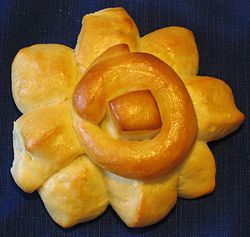Mutschel
 |
|
| Type | Bread |
|---|---|
| Place of origin | Germany |
| Region or state | Reutlingen |
| |
|
The Mutschel is a traditional star-shaped bread from Reutlingen, Germany. The pastry, and the corresponding Mutscheltag (Mutschel Day), have probably existed since the 13th century. Mutscheln are roughly circular and come in various sizes: usually approximately six inches in diameter, but bakeries often offer breads three or more feet in diameter. They are sometimes made in sweet varieties.
There are several theories about the origin of the bread form. One is that the high central part of the bread represents the castle atop the Achalm, a hill next to Reutlingen, and the eight points of the star represent medieval guilds. The star could also have Christian allegorical meaning as the Star of Bethlehem. A third possibility is that Reutlingen baker Albrecht Mutschler invented the shape in the 14th century. This baker was mentioned first in the 1435 Reutlinger Heimatbuch.
On Mutscheltag (the first Thursday after Epiphany), townspeople gather in halls and homes to play dice games, the winner of which earns parts or whole Mutschel breads. The Mutschelspiele (Mutschel games) consist of small games scored by tally marks. The games are won both independently and by grand total at the end of the hour or night.
In the neighboring community of Pfullingen, there is a similar custom with a cake called "star".
Common dice games are:
Played with one die. Player number one lays the die in front of him with one dot face up. He passes it to his neighbor on the right, who rolls and adds the numbers together (one dot from player one and the new roll from player two). She passes the die to the third player, who rolls and gets a new total. Whichever player reaches 21 or higher receives a tally mark. Play as long as desired. Choose whether the most or fewest tally marks wins. Note similarities to 21 (drinking game).
Played with three dice. The point of the game is to get the smallest three-digit "house number." Each player rolls three times. After each roll, write down the die result in the hundreds, tens, or ones place. The three rolls will therefore create a three-digit number. That is, a roll of one should most properly be written down in the hundreds place so that the house number can be as small as possible. A roll of six should be in the ones place.
Played with three dice. The player who doesn't roll a sequence (1 2 3, 2 3 4, 3 4 5, or 4 5 6) receives a tally mark against him. Alternatively, players could play Yahtzee-style where after the first roll of three dice, a player can keep one or two dice and roll the others up to two more times. If after the third roll there is no sequence, she receives a tally mark against her. Play as long as desired.
...
Wikipedia
